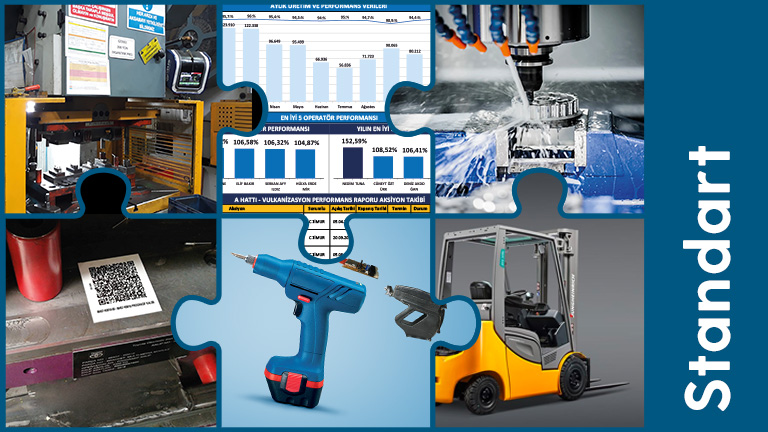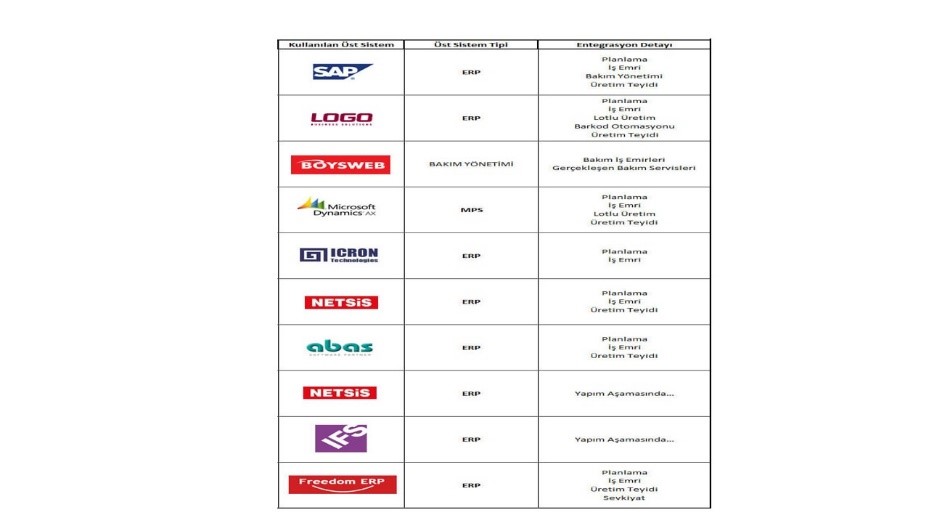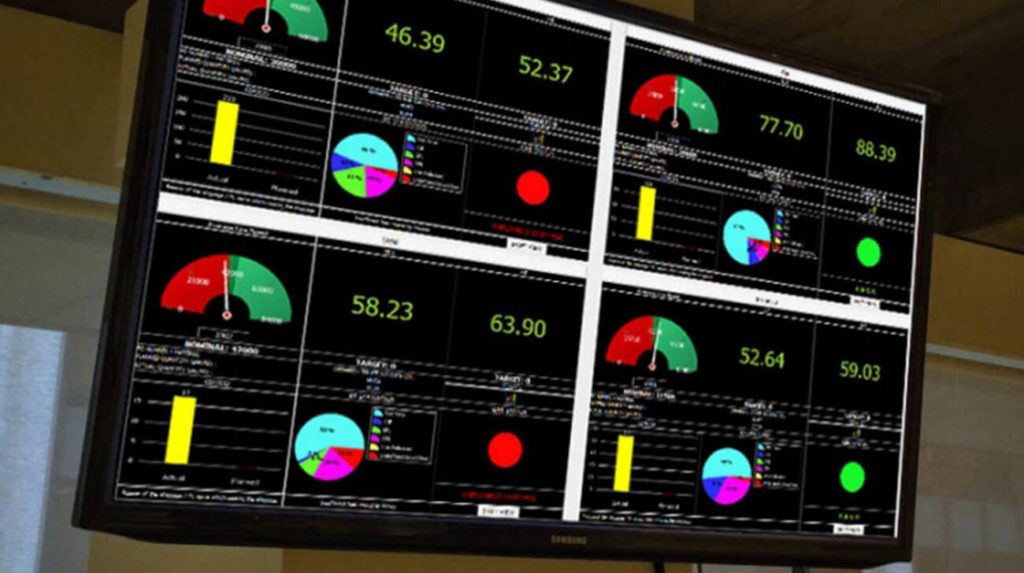
The targeted goal; companies to adapt to MES Systems more quickly.
Customizations play an active role in the acceptance of the program by the operators, who are the most important people for collecting data from the field. We can define the coming together of two different systems that do not know each other as a texture harmony. One of the systems here can be defined as MES Systems and the other as the established production culture of the factory. Factories should be implemented with customization in a way that will facilitate their work, without changing the established culture of the factory, without imposing additional burden on people.
This does not mean that if there are mistakes in the culture, they will accept them as they are and the MES System will be customized upon these mistakes. In this part, the experience of your MES solution partner stands out. Identifying the correct known mistakes settled in the factory culture and taking measures for them rather than making improvements will save institutions from loss of time and money. These wrong customizations to be made during the installation process can be called a stillborn project investment.
In the second question, “Is Customization a sectoral need or desire”, it would be better to elaborate on whether the needs for all production sites in the same sector are the same, or are the requests of companies in the same sector different or interpretable.
“Sectoral needs take shape in line with the demands of our customers”. To explain with an example, there is a “Forklift Information” development that we have activated remotely in a company at the time of the Covid-19 outbreak, to be used in all sectors. Its purpose is to meet the raw material needs of the operator as soon as possible, to remove the produced product from the environment without occupying the production area, to record and report information such as request time-acceptance time-delivery time, etc. is to do transactions.
The request is the same in all sectors, but customizations such as its use, screen view, form of notification (for example, the forklift operator is informed instantly by sms, mail or a tablet in the forklift).
Are production sites that cannot fully convert their own production to digital at MES standards alone? Who should be chosen, Supplier or partner? and what should be the polar star understanding of the institutions?
Customizations rise on two different values. These;
MES Partner: Experience, staff background, hardware development skills are important.
Experience: The ability to adapt the software by formulating it should be sought for the processes in the production area. The ability to apply the concept to the field must be developed. This is due to the fact that the MES partner has done one-to-one or similar studies. It is important to combine theory and practice in customizations. The wide range of technology manufacturers’ sectoral range is a proof of their privatization and adaptation competence.
Staff Infrastructure: Field experience of project coordinator providing customization services is very importance. Another issue is the segmentation of the staff that will provide the customization service.
It would be appropriate to evaluate a person who has experienced filling lines in a parallel process, and to appoint as a project coordinator to companies that produce one-to-one or similar processes in those who have experience in injection or hair shaping processes.
Hardware Development Capability: Each machine and process has one in the world and is unique.
Even though thousands of same model machines are put on the field by the machine manufacturers, the machines are differentiated in their own right due to the specific difference of the raw material they work with, the operator qualification they use, and the operation order in the factory layout.
In these processes, beyond being able to integrate with peripherals, the ability to transform them is also a must.
Until now, any customization request sent to us has not been met negatively. The biggest problem we face in customizations is that the other side does not allocate sufficient budget for this work. The reason for this is that the person who wants to customize does not do a detailed studies and does not correctly analyse and realize what this customization will add to the company. But with the right study, they can find enough budget for themselves. The fact that the person who wants customization does not transfer his / her information when leaving the job can cause the customization to be stillborn. Companies cannot use their existing power, they are not even aware of it. Our humble suggestion is that the MES Systems responsible in the company should do this with the same care, just as we can document all the work we do and see it retrospectively.
All companies using MES Systems can request customization.
According to the current job, the operator manually entered the information on a given work order sheet. Since inkjet screens are small and there are many different characters and different cursors in the texts, correct writing is a process that requires high attention. Failure to do this process correctly was causing a great burden to companies. The material to be ordered is transferred to the reel and then the existing text is printed correctly again.
In order for these operations to be carried out automatically, when an integration between the two systems is established and the work order is loaded, only the printer is left to the personnel and the correct article is printed.
In addition to the customizations in accordance with the internal flow of the companies, there are also sector-independent joint demands overlapping with each other. These requests can generally be grouped as visualization and reporting of data, requests for integration with other systems, and customization requests in user interfaces.
We offer an independent and flexible interface where users can design changes in endpoints and reporting.
The customization demand comes to us primarily from the production area. After the factory starts to absorb the MES System and see what they have added to the company, requests from each unit are increasingly coming. If we need an extreme example of this, a company’s human resources department chooses the employee of the month and even wants to show a picture of that staff in the Andon screen. A different perspective can be interpreted as a different source of motivation. Apart from this example, there may also be a unit of quality, maintenance, occupational safety.
Demands also come from units that use software such as QDMS. Since the data is entered into the existing system manually, it cannot be mentioned that they are used effectively because they cannot be fed from the field. When these software are integrated with MES, their functionality increases just like ERP. To summarize, companies request customization of units for all conceivable data that can be collected from the production site. It significantly reduces the workload of these people and provides the right information instantly.
First of all, success in MES Systems, which are applied to companies, passes through a well-designed architecture and functionality. Therefore, it would be better to talk about our architecture first and then to mention our customization solutions.
Online Monitoring:
With these tools, you can instantly query and monitor all losses on the basis of machinery, equipment, line, personnel and work order. In addition, since we support mobile and web platforms, we provide companies with remote access to the MES System.
Integration:
Our MES System, data collection system from the field can work in integration with many higher systems. The table in the image shows the contents of the integration studies we have done with the upper systems and some companies.

ANDON Management:
It is a software supported electronic system developed for the business to see and minimize the manufacturing costs.
Major Features

After the companies convey their requests and the result they want to reach with this request, they create a requirement document as can be seen on the screen. The purpose of this document is to ensure that the requests of the other party and what we offer exactly match. During these customizations, it is necessary to work with us on other systems, and in such cases, we need to include the people who will do these works in this process. After this requirement document is approved by both sides, studies/works are started. In short, the reporting of requests until the approval process is provided in this way. Then, these requests are transferred to the software department and the work begins.
Sustainability is provided by being documented. The customizations and developments we make are recorded with our document management system, and additions to the customizations we have made, when requested, proceed on the basis of our document management system.
The answer is no, sincerely.
In order not to have problems in version transitions, many tests and verification processes are carried out, starting from the software department until it is commissioned in the field. The testing process begins with the development and verification of the software department by different personnel. Subsequently, the new version is tested by the independent test team of the software department. The excels passing through this team are tested by the customer advisor before being uploaded to the customer.
As the most crucial point in this test process, it is an exact simulated example of the live environment that customers offer us. In this test environment, situations arise that we cannot test in the office and that no one can predict. At this stage, we know the reason for their occurrence that MES programs can be integrated with more than one side program and we do not have the chance to provide these integrations in the office. If a problem is seen in the test processes at this stage, the scenario returns to the beginning and all stages are repeated.
If there is no problem, our version update will be done and we will be able to go live.
Sectoral experience is actually know-how. The experience gained in different plants creates a leverage effect in fields that have not yet experienced this. The support for applying this know-how to the field and adapting it to the corporate culture is a value that cannot be measured numerically in the background. Being a partner includes acting synchronously with the company in line with the same goals. The purpose of the MES partner is to increase the efficiency of the institution it serves, rather than digitizing it. In the light of the data of the digitalized field, there should be support in which engineering works will increase the efficiency. The personnel appointed as MES responsible in the institution must also have the infrastructure to provide theoretical and technical support in a sustainable way. If necessary an academy where operational studies can convey their theory should be included. Likewise, by providing the technical infrastructure, it should include an application center or school that can put operations such as kaizen, 5s, smed in the academy into practice. It is more correct to qualify a MES manufacturer that does not have these infrastructures, namely academy and application center, as a supplier, not a partner. Because the journey of digitalization with the partner is a journey that continues to reach the goals from the starting point and always do better, while the supplier approach is as fit to the field as the establishment of the MES System and systematic support. Platforms and activities to be provided to share sectoral MES experiences among institutions are another value offered.
Rather than meeting the demands, the MES partner should propose the experience it has gained and the improvements and customizations it can offer. In the institutions of experience ethics, it should be a priority to solve many needs and reflect this to the companies in the partner sector.